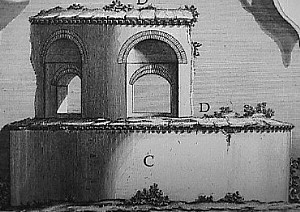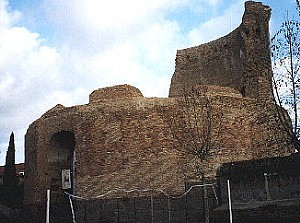Constantine's execution of his son Crispus.
25 July: Helena dies at Naples. She is subsequently buried in Rome within the mausoleum attached to the basilica of Saints Marcellinus and Peter.
25 July: Fausta commits suicide at Rome.
3 August: Constantine leaves Rome and never returns.
Eutropia converts one of the halls in Helena's palace at Rome (the Palatium Sessorianum) into a chapel. This chapel later becomes Santa Croce in Gerusalemme.
Santa Croce in Gerusalemme
Santa Croce, one of the "Seven Churches" of Rome, owes its origin to the Empress Helena, mother of Constantine, who in her zeal for Christianity made a pilgrimage to Jerusalem and brought back a collection of relics, including a portion of the Saviour's cross, for the purpose of forming a pilgrims' shrine for those who could not afford time and money for the journey to the Holy Land. The church she founded, was probably a hall of the Sessorian palace in which she resided; it was called Basilica Heleniana, or Sessoriana.
The primitive church was rebuilt by Pope Lucius II, in 1114, and modernized in 1743 by Gregorini, who added the baroque facade. The campanile dates from 1196.
The sacred relics preserved in the church include a part of the Cross and of its inscription, one of the nails, thorns from the crown, and the finger with which St. Thomas convinced himself of the reality of the wound in the side of Christ.
The tribune is covered with frescos reprsenting the discovery of the Cross. The oldest part of the church is the chapel of St. Helena in the crypt (Ladies are not permitted except on the festival of the saint, March 20th), the floor of which was built upon a soil composed of earth brought from Jerusalem.
J. & M.L. Fattorusso, Rome Eternally Beautiful (Florence: Giuseppe Fattorusso,1937), p. 598.
| |
Helena's mausoleum at Torre Pignattara (so called from the pignatte, or earthen vases built into the vault to lighten its weight) is round in shape, and contains seven niches or recesses for sarcophagi. One of these sarcophagi, famous in the history of art, was removed from its position as early as the middle of the twelfth century by Pope Anastasius IV, who selected it for his own resting-place. It was taken to the Lateran basilica, where it appears to have been much injured by the hands of indiscreet pilgrims. In 1600 it was carried from the vestibule to the tribune, and thence to the cloister-court. When Pius VI added it to the wonders of the Vatican Museum, it was subjected to a thorough process of restoration which employed twenty-five stone-cutters for a period of nine years.
 
Elevation of and section through the Mausoleum of St. Helena. Detail of plate xvi of Le Antichitą Romane III.
The reliefs upon it are tolerably well executed, but lack invention and novelty. They are partly borrowed from an older work, partly combined with various sources in an extraordinary manner; horsemen hovering in the air, and below them, prisoners and corpses scattered around. They are intended to represent a triumphal procession, or possibly a military decursio, to which allusion has been made above.
 
It may appear indiscreet and even insulting on the part of Anastasius IV to have removed the remains of a canonized empress from this noble sarcophagus in order to have his own placed in it; but we must bear in mind that although the Torre Pignattara has all the appearance of a royal mausoleum, and although the ground on which it stands is known to have belonged to the crown, Eusebius and Socrates deny the Helena was buried in Rome. Their assertion is contradicted by the "Liber Pontificalis" and by Bede, and above all by the similarity between this porphyry coffin and the one discovered in the second mausoleum of which I have spoken, -- that of S. Constantia, on the Via Nomentana.
Rodolfo Lanciani, Pagan and Christian Rome (Boston: Houghton, Mifflin and Company, 1893), 196-8.
 
Visual Comparison, Imperial Baths, Trier, c. 310, Torre Pignattara, Rome, c. 320-26

View into the Greek Cross Hall of the Vatican Museum. The sarcophagus of St. Helena is within the niche center right, and the sarcophagus of Constantina is within the niche center left. Perspective from Letarouilly's Vatican.
| |

chronology of Santa Croce in Gerusalemme
180-211:
Numerous tiles with brick stamps with the names of Septimus severus and Commodus, found on the roof of the basilica.
202:
Inscriptions of a water-pipe found in front of the basilica.
317-322:
The palatium Sessorianum is in possession of the Empress Helena, whose name is preserved in an inscription on a base of a statue, now in the chapel of S. Elena. Other inscriptions referring to Helena found in the neighborhood.
313-361:
Founding of the basilica and donations of Constantine the Great or of one of his sons; among these perhaps also a relic of the Holy Cross.
before 348:
Discovery of the Holy Cross and diffussion of the cult of the Cross in the Occident.
Richard Krautheimer, Corpus basilicarum Christianarum Romae: Le basiliche cristiane antichi di Roma (sec. IV-IX) (Cittį del Vaticano: Pontificio istituto di archeologia cristiana, 1937-).

Reconstruction of Santa Croce in Gerusalemme by Lanciani based on existing ruins, late 19th century. The amphitheater is named Castrense. The ruins to the northeast of the sessorian hall is a Templum Veneris et Cupidinis (Temple of Venus and Cupid).

First plan of Santa Croce in Gerusalemme (after Krautheimer). The grid is in increments of 10 meters square.

cad collection, etc.
Above these arches the transverse walls rose to a height if 18.25 m. above the present level, thus reaching almost the height of the original roof; the last remains of these transverse walls above the arches are preserved in the gouges in the two long sides of the ancient construction.
[T]he diameter of the columns which today divide the nave and the aisles, is precisely 88 cm. which corresponds almost exactly to the thickness of the arches and the insets. Thus it would be a working hypothesis to assume that these very columns were the original supports for the transverse arches.
Richard Krautheimer, Corpus basilicarum Christianarum Romae: Le basiliche cristiane antichi di Roma (sec. IV-IX) (Cittį del Vaticano: Pontificio istituto di archeologia cristiana, 1937-), p. 190-1.
See also: a basilica in the Sessorian palace within The Life of Pope Sylvester.
|










